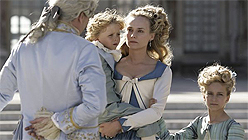In 1995’s A Single Girl, probably his best known film in the U.S., Benoit Jacquot tracks a young chambermaid through one workday as she ponders a big decision. The French writer-director’s smart and ultimately wrenching Farewell, My Queen takes a similar course — only this time the protagonist toils for Queen Marie Antoinette, and the story opens on July 14, 1789.
Viewers needn’t be good with historical dates to understand what’s going on. Reports of unrest in nearby Paris are arriving at Versailles, and Marie Antoinette is among the least popular figures with the about-to-be-revolutionaries. There’s one other name that inflames the men and women in the street: Gabrielle de Polignac, a close (and perhaps intimate) friend of the queen whose life at Versailles was subsidized by the crown.
Our envoy to this pampered demimonde is not so exalted. Sidonie (Lea Seydoux) is simply the “assistant reader” to her adored queen. Sidonie’s job is to amuse Marie Antoinette (Diane Kruger) with novels and plays, although sometimes her majesty prefers the 18th-century equivalent of the latest fashion magazine. Playing the humblest of royal servants, Seydoux could hardly appear more different than in her biggest megaplex-movie role: the baby-faced assassin of Mission: Impossible — Ghost Protocol.
There’s glamour at Versailles, but Sidonie rarely encounters it. She’s tormented by mosquito bites as she travels through the chateau’s dark, cramped servants’ corridors. (The film was actually shot at the palace.) Cinematographer Romain Winding follows Seydoux with a handheld camera, recalling the many Jacquot movies that try to keep pace with restless contemporary women. The fire- and candlelit interiors, however, array shadow and glow like Old Master paintings.
Sidonie occasionally encounters Gabrielle (A Single Girl star Virginie Ledoyen). But the imperious beauty never acknowledges her, or just about anyone else; only Marie Antoinette is worthy of Gabrielle’s voice, which isn’t heard at all in the film’s first hour.


